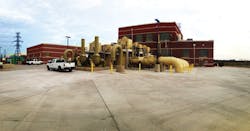The city of Dallas’ Water Utilities is a not-for-profit department, providing water and wastewater services to approximately 2.4 million people in Dallas and 27 nearby communities. Its operations are funded solely by the water and wastewater rates paid by customers.
One of the principles of the utility’s mission is to “continuously plan for the future.” In doing so, the capacity of the wastewater system is regularly upgraded and re-assessed to improve the utility’s ability to meet customers’ needs by replacing aging infrastructure.
Pump Choice
2002 brought about the start of a system design upgrade process. The Dallas Water Utilities teamed up with Freese & Nichols and Odessa Pumps to evaluate its options. They began to plan and design a solution to repair aging infrastructure and hydraulically connect the Dallas and White Rock plants, both located inside the Central Wastewater Treatment Plant (WWTP), to provide treatment flexibility.
Over the next few years, the groups launched a collaborative effort to analyze the features and benefits of the traditional dry well/wet well dry pit station versus a vertical turbine solids handling (VTSH) pump layout. Based on the calculations of initial capital cost, cost of operation and overall cost of ownership, the decision was made to move forward with six Fairbanks Nijhuis VTSH pumps (two 1,000-hp and four 800-hp pumps).
“The vision of the Dallas Water Utilities has always been to be both an efficient provider of superior wastewater service and a leader in the water industry,” said Regina Stencel, P.E., project manager for the city of Dallas.
“As we evaluated our options, along with its reliability and efficiency, one of the benefits that kept coming back to the VTSH was its reduced construction costs—a direct savings we could pass along to our consumers,” Stencel said.
Stencel added that use of the existing, classic pumps would mean the utility would be faced with building both a new dry well and a wet well pump station, which would cost approximately $12 million. The decision to go with the VTSH pumps meant that only a new wet well would be required, thus saving approximately $6 million in construction costs. In addition to the direct construction cost savings, installation of the pumps meant the utility would be able to take two pump stations off line when the new influent station was commissioned.
Deluge of Relief
The pumps have successfully been in operation for more than two years, and the Dallas Water Utilities treatment plants now have the capacity to pump 425 million gal per day (mgd) with a firm pumping capacity of 360 mgd.
In 2002, when the utility began planning a preliminary infrastructure upgrade, no one could have imagined that in 2015, 10 years after the final design was completed, the city would be hit with more than 62 in. of rain. This would turn out to be the highest total rainfall experienced this decade, and nearly three times more than each of the previous four years.
“Without the new VTSH pumps in service, the old system may have been compromised.” said Jerry Freedle of Odessa Pumps. “The Dallas Water Utilities did the right thing by making this upgrade.”
